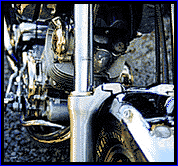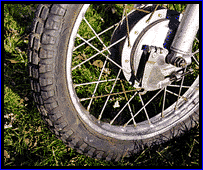|
|
||||||||||||
|
by Sonic We as humans are a funny lot. We have strange habits, believe in a wide assortment of wonderful things, and oddly enough we rarely listen to those who can usually help us. Firstly though I'll give you the low down on the Honda 400F featured in the last article. As it turns out, after many hours of grief by all involved, it was discovered that the floats on the bike were made when brass floats were no longer the fashion and the new fashion of light plastic floats had not yet come into being. The floats on this machine were made from something still unknown to me. This stuff was probably wonderful for the first 15 years or so, but as with everything, age eventually takes it toll (Yeah, I need glasses now. What? Who are you? ... where am I? Is it medication time yet? - Ed). It appeared that this material was absorbing the fuel in the carbs, not enough to cause gas to fill the float itself but just enough to make all the floats a little bit heavier. This increase in weight would allow more fuel into the carbs, effectively causing them to flood. But only slightly. It wasn't quite enough to stop the engine, but just enough to cause it to produce black smoke from the exhaust (Do these sound like the words of a desperate man? - Ed). After the floats were changed, in the now million dollar carburetors (on the hundred dollar bike!), it ran much better, yet still exhibited a slight amount of black smoke. I later learned from an OMG reader, that the pilot jets were originally fitted with rubber plugs. Our carb set had these plugs removed at some point, either by accident or by the adrenaline pumped youth of by-gone years. Any how, it seems to be running better, at least for a twenty year old machine with an apparently original power. Anyway, over to my Virago. For anyone who hasn't experienced the joy of a fork seal leak,
Enough about my bike, over now to this issues subject. It seems to me that as youths growing up, we always knew better than our parents, and now as adults we still feel like we know more than the person who's trained in what we think we know it's all about. I can take my own tree down ... I can't believe how much a new roof costs! I do my own taxes. Yup, we know much us humans we do. Enter my all knowing pal ... "Wow Sonic said he couldn't find a good kids bike for under 800 bucks. Couldn't have looked too hard, 'cause I found this great 1974 Yamaha MX80 for $300. Talked him down to $150. I'm better than Sonic, I'm better than Sonic". I'd expect more from my best friend some how, but I guess we're all bargain hunters at heart.
I foolishly became involved in this 'project' while chatting over some other business with said pal, and the topic of bikes came up. Can you believe that? He confessed he'd brought, excuse me, 'traded' the equivalent of $150.00 worth of good stuff to buy this MX 80 that was having "a few problems". Walk away, walk away. Don't get involved ... "What's it doing?" I asked. Big mistake. My ex-best friend began to describe the list: "The back brakes don't work. The front ones barely stop you. The front wheel rocks back and forth between the forks. The clutch cable broke the other day. There's oily little rings on the top part of both forks ... I think it might need new tires and a tune up. Oh, and it runs but it's really loud. What-da-ya think?" SS SSU SSUCKER! Sorry, but sometimes you need tough love. As far as 23 year old kids bike goes, cosmetically it wasn't bad. It still had its original
I was really quite surprised at the fact that most of the parts we required to rebuild this little bike were still available from Yamaha. All the cables, bearings, assorted bits and unique bites were in stock (and in Canada) and were reasonably priced. I started with the motor, draining the old transmission oil and removing the flooded gasoline from the crankcase. The breaker point was replaced, which is incidentally located behind the rotor - requiring a Yamaha rotor puller (why put something that needs to checked and changed regularly behind something that is a sod to remove at the best of times?). The L.H.S. engine cover (the one that supports the clutch return spring) was inspected to see if it could be saved. Not! Welded then. Nope! It's made from magnesium so it just melts. How do I know it melts?... I was able to weld up the oil injector mount on the intake, saving us some cash, and realizing that if that had a bit bigger crack in it the motor would likely have seized. With the motor back in I rebuilt the carb, pretty good at it now after the 400F thing. Brass floats - good. Not leaking - even better. The carb was replaced on the intake and the bike was fired up. HOLY COW IS THAT EVER LOUD!! Ears still rigging I pulled the front end off and disassembled the forks. Yuk, the springs actually looked like solid tubes, nothing like a spring at all, The gaps
For an old bike that had sure seen better days I'm pleased with it's performance. The motor still has plenty of kick, the transmission is fairly smooth and most of all doesn't slip out of gear. Yes, we humans are a funny lot. I guess if I'd looked harder I could have found myself another project much sooner, but I didn't listen to those folks telling me about the bike that's in a neighbours garage that once belonged to this guy ... except he moved away and these other kids had it a while but dumped it into the creek ... and then their older brother fished it out and kept it for a summer, or was it two?... I didn't have to listen - I have 'friends'. |
||||||||||||
© 1997 Canadian Motorcycle Guide







